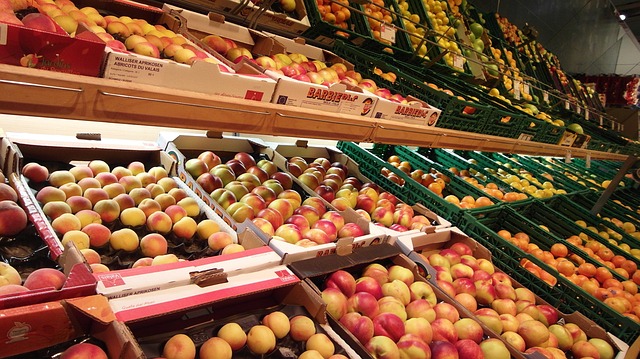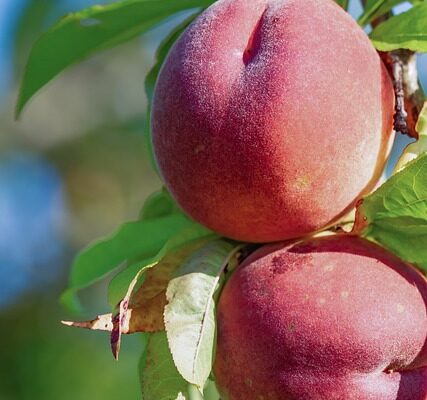Peach has plenty of health benefits. It has Vitamin A, fiber to balance cholesterol, Vitamin C acting as an antioxidant, and more. Let’s read on to find out.
Peaches, like a soulmate, are sure to attract your eye while you’re scouting out the farmers’ market with their sunset-like blend of red and orange colors and tantalizing sweet aroma.
However, their benefits go beyond the surface. When you bite into the ripe fruit, you’ll be greeted with a luscious, soft, melt-in-your-mouth taste and texture, as well as a plethora of good-for-you nutrients.
What exactly are peaches?
Peaches have been around for much longer than the peach emoji – more than 3,000 years. The stone fruit was first cultivated in prehistoric China, and it moved from there to Europe and modern-day Iran before being scooped up by Spanish missionaries and brought to other countries.
In the United States, more than 100 peach types are grown. The flesh of the fruit might be yellow, white, or (rarely) red. However, most varieties seen in the United States have yellow flesh that is delicious yet slightly acidic. White peaches taste nearly as sweet as honey, have little acidity, and lack the classic tang of yellow peaches.

These Apricot Health Benefits Will Convince You to Try the Summer Fruit
Peaches differ not only in color and flavor but also in the pit, commonly known as the stone. A clingstone peach is one that has its flesh clinging to the stone.
The pits are mechanically removed from this peach type, which is largely employed in the commercial canning sector. Peaches with flesh that is not attached to the stone, on the other hand, are known as freestone peaches.
The pit in these peaches is easily removed with a slight twist.
Nutritional Information for Peaches
When you need a filling but light snack that’s also high in nutrients, reach for a ripe peach. How many calories are in a peach? A medium fruit contains only 59 calories, which is half the amount contained in a medium banana. (Although eating fruit of any kind is beneficial, calories should be weighed carefully.)
According to the USDA, here is the remaining nutrition information for a medium yellow peach:
- 59 kilocalories
- a gram of protein
- 0 grams of fat
- 14 g carbohydrates
- 2 g of fiber
- 13 g of sugar
You’ll also get a lot of nutrients with each bite, which leads to…
Peach Health Benefits
As if the wonderful flavor wasn’t motivation enough to nibble on peaches, these nutritional advantages indicate the stone fruit is a nutritious powerhouse.
Quick and Simple Fiber Source
You don’t have to force down a bowl of flavorless bran cereal to get your fiber fix. By eating one medium peach, you will consume 2.25 grams of the macronutrient. You will be one step closer to fulfilling your recommended daily intake (R.D.A.) of fiber, which is 28 grams per day. Around 60% of those few grams is insoluble fiber (the type that adds weight to stool and helps food pass faster through the stomach), while the rest is soluble fiber.
Why do we need Soluble and Insoluble Fiber?
Fiber not only promotes satiety and makes you feel fuller sooner, but it can also help manage blood sugar levels and decrease cholesterol. So, how exactly does it work?
Fiber, particularly soluble fiber, can limit sugar absorption and help control blood sugar levels, whereas insoluble fiber can help reduce the chance of developing type II diabetes. Fiber may help prevent high cholesterol by lowering triglyceride levels and LDL while increasing HDL levels.
If the health benefits of peach isn’t enticing enough, fiber can also help reduce constipation.
Serve with Vitamin C
Sorry, oranges, you’re not the only vitamin C-rich fruit in the grove. According to the USDA, peaches contain almost 10 milligrams of vitamin C or about 13% of the R.D.A.
While you won’t be able to meet your daily requirement by eating a single peach, you can still benefit from some of the vitamin’s health benefits, such as its antioxidant properties. What makes antioxidants so wonderful is their ability to fight free radicals, and they may also help boost your immune system. (Also, strawberries are high in vitamin C.)
Here’s the lowdown:
When free radicals are created in excesses, such as by smoking, pollution, or radiation, and cells do not remove them rapidly enough, a process known as oxidative stress ensues.
Cell membranes, proteins, lipids, and D.N.A. can be changed in detrimental ways during this process, potentially leading to chronic and degenerative disorders (for example, cardiovascular disease, cancer, and rheumatoid arthritis).
According to an article published in the International Journal of Biomedical Science, antioxidants such as vitamin C swoop in to stabilize free radicals and block the damage they cause.
Does your hair require antioxidants as well?
But that’s not the only way peaches’ antioxidants help keep you healthy: According to a study, vitamin C boosts the formation and improves the function of white blood cells, particularly the specialized cells that attack invading bacteria and viruses.
Furthermore, this peach health advantage may help your skin look as lush and smooth as the fruit itself. Vitamin C helps your body generate collagen, a protein that is vital for maintaining your skin smooth, tight, and strong.
According to some research, the vitamin helps fix the collagen molecule structure, stimulates messenger R.N.A. molecules, and instructs the skin’s fibroblasts (the cells in your connective tissue) to produce collagen.
Blood Pressure Management
One medium peach has 6% of the R.D.A. for potassium, which implies peaches can help regulate blood pressure.
High salt intake has been related to high blood pressure, which means the heart pumps more blood, and the arteries are narrower than they should be.
According to the C.D.C., combining high sodium intake with low potassium consumption may increase your risk of heart disease and stroke.

Help to Promote Healthy Vision
Each medium peach includes 24 micrograms of vitamin A, a nutrient that, in some situations, can help enhance your vision. This is a many benefits of peach.
If your body has plenty of vitamin A and you eat a lot of vitamin A-rich foods, your vision will not improve. However, if you’re deficient in vitamin A and it’s affecting your vision, which it may, eating vitamin A foods can improve your vision.
Peaches contain 243 micrograms of beta carotene. This is a type of carotenoid found in plant-based foods that can be converted into vitamin A.
Foods to Eat Together for Maximum Nutrient Absorption
The lutein concentration of peaches rounds out the fruit’s eye health benefits. This carotenoid cannot be turned into vitamin A, but it is found naturally in the central portion of the retina of your eye.
Lutein can also help protect the eye from light-induced free radical damage. This can contribute to age-related macular degeneration, an eye illness that causes a loss of central vision.
Some research has discovered a specific link between the carotenoid and the disease: According to the University, higher lutein intake is connected with a lower incidence of age-related macular degeneration.
Peach Health Concerns
An allergy to peaches is possible, with symptoms ranging from moderate to severe, including hives, G.I. difficulties, nasal congestion, and, in severe cases, anaphylaxis. Your reaction to stone fruit can change over time, making it better or worse.
You might experience an allergic reaction to stone fruits in general if you consume them uncooked. Stone fruit proteins are comparable to those found in (apparently unrelated) pollen and can cause symptoms of oral allergy syndrome, like a scratchy throat or hives in the throat.
How to Purchase and Consume Peaches
According to the University of Georgia Extension (based in the so-called Peach State), look for fruits with firm, fuzzy skins. And handle them with caution because they are easily bruised. When your peaches ripen, you should eat them within a couple of days since they will over ripen if you wait too long.
Peaches from the supermarket will have a different flavor than those from a roadside stand or farmers’ market. To begin, commercial grocery store peaches are frequently mechanically brushed after harvest to eliminate that trademark peach fuzz, whereas peaches from the small grower down the road are typically tree ripened and delivered directly to the consumer.
To Conclude benefits of peach
If the peaches available aren’t up to your expectations (or the farmers’ market is closed for the season), you can use frozen slices or canned peaches, which are just as healthy when packaged in their natural juices.
When it comes to eating them, you can never go wrong with chopping them up and eating them raw.
In your salad, of course. A deliciously cool summer salad topped with peaches will never let you down. You may also broil sliced peaches for a slightly charred, caramelized flavor.
As a foundation for salsa, if you’ve never tasted peach salsa, you should try it. Here’s your chance to make your own version of the sweet and tangy dip.
In the form of frozen beverages. Making a creamy peach smoothie or alcoholic drink using fresh or frozen peaches is sure to delight. You can definitely make a peach margarita or peach daiquiri or peach margarita — just add the extra salt, please.
For dessert. Peaches, F.Y.I., are great when combined with yogurt or cottage cheese. Peaches and cream are usually a nice option for something more decadent.
